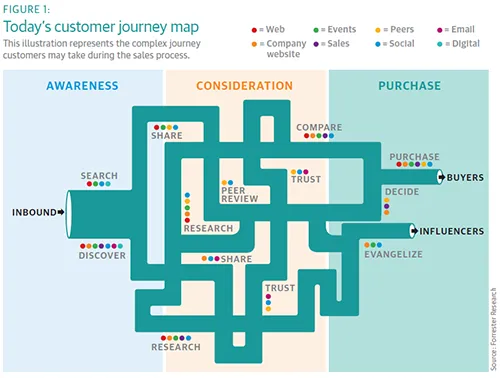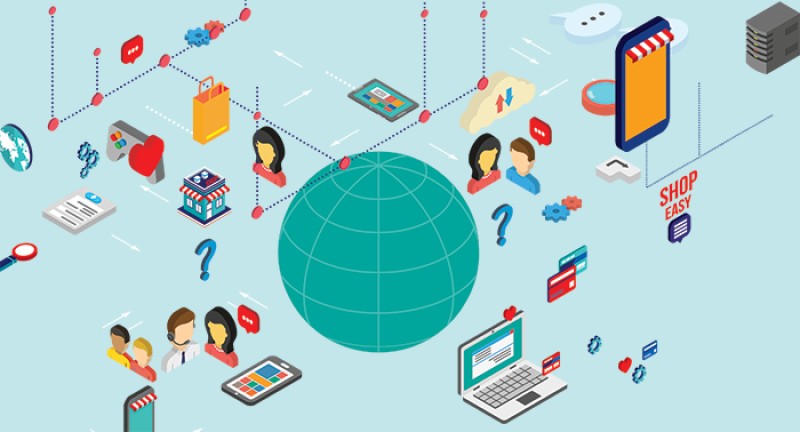If you’re a customer experience leader, you are likely familiar with the concept of customer journey mapping. It’s a way for companies to understand how customers interact with the brand during purchase and service interactions. Many companies plot out all customer touchpoints and paths as an efficient way to understand the experience most customers have.
The concept has a lot of merit in that it provides a visual representation of what customers experience with your brand, and often reveals areas of opportunity to remove friction or enhance what works. And advances in marketing automation and other technologies allow marketers and customer experience leaders to own journey mapping projects in addition to making them actionable, instead of relying on IT to do the heavy lifting.
Customer journey mapping has been around for years, and many companies do at least some form of it. Yet even today, most customers don’t feel they’re getting the attention they deserve. Four out of five customers feel the brands that they buy from don’t know or treat them as individuals, according to a recent study from IBM and Econsultancy. In addition, only 35 percent of consumers say communications from their favorite brands are relevant.
Why the disconnect? Part of the reason may be that journey mapping, for all of its advantages, doesn’t go far enough toward the ultimate in customer relationships— the one-to-one interaction.
A journey map depends on creating a limited number of buyer personas and listing steps that are typically linear—awareness, consideration, and decision. Personas by definition are an attempt to group people in order to make it easier to deliver relevant content on the phase of the journey they are in. The goal of one-to-one relationships, on the other hand, is to treat each person individually based on their unique needs, intention, context, and preferences, with the intent of moving them toward an objective (typically a purchase). In the one-to-one reality, an individual’s “journey” is rarely linear, looking something more like The Flight of the Bumble Bee. Google and Ipsos research found that “mobile has fractured or fragmented forever consumer behavior into dozens or hundreds of short, fleeting, intent-driven moments.”
It becomes clear that when you look at the complexity of actual journey maps, individuals often don’t fit perfectly into one persona. They often take on multiple personas, switching back and forth among those personas based on context. This makes it increasingly difficult to spot behavioral patterns that indicate potential problems, such as impending cart abandonment. And they increasingly jump around among channels such as the Web, SMS, chat, social, and other channels, even when eventually ending up in a physical location like a store.
Once a journey has been mapped, it can also be difficult to meet consumers’ needs in an automated and scalable way. Many of the existing marketing automation systems used to deliver relevant experiences during customer journeys are not tuned for real time. Downloading a white paper and getting a relevant email based on that trigger event is simple. It’s a whole different matter to respond immediately to the fact that a person is expressing intent by being in a particular location at a particular moment in time and has a purchase history that should enable the system to present a relevant offer.

Using data to sense and respond in real time is a step forward, but is often typically simplistic in nature and dependent on predefined rules. Self-optimizing solutions—in which machines analyze results with big data analytics to evaluate all possible variables—are gathering steam, but are not yet mature enough to match consumer expectations.
There are, of course, plenty of situations where existing attempts to leverage journey maps via marketing automation systems work very well. Triggered communications based on behavior or history do add an element of relevance and customer understanding to interactions, and they do begin to remove friction from some experiences. But for the most part, today’s customer behavior is very complex and does not lend itself well to a linear, persona-based approach.
Travel with customers on their non-linear journey
Just because customers are harder to map doesn’t mean that we shouldn’t still try to meet their needs. It just requires a new way to think about technology and analytics. Specifically, advances in three areas will help companies match the emerging expectation of immediacy from unpredictable customers:
Big data: The more information you have about individual customers, the more intricate your customer journey map can be to personalize their experience. Though Big Data is a common buzzword, it’s also the very real lynchpin of any strong customer strategy. Managing it continues to be a challenge; VentureBeat recently reported on an IDC study that estimates 80 percent of customer data is wasted due to “immature enterprise data value chains.” Companies are still figuring out how to set up their data warehouses and mining systems, and align internally to collect, analyze, and act on the insight that’s hidden among the ones and zeros.
Fast data: Data scientists refer to the enormous amount of real-time data being generated as a “fire hose.” Its volume, velocity, and variety accelerates by the moment. Not too long ago, it would have been nearly impossible to manage, let alone analyze it very quickly. The speed with which data can be analyzed and disseminated to relevant business units is now the priority business challenge for many data professionals these days. Firms implementing/leveraging “streaming” platforms capable of capturing, processing, and analyzing each event and its relationship to other relevant data in real time are beginning to deliver true one-to-one customer interactions.
Machine learning: Machine learning is defined as “the ability of a system to improve its performance of a task based on experience and data.” Programmers create algorithms that are automatically adjusted based on new data coming in to improve a machine’s performance. Business rules need to be adjusted on the fly to create more personalized interactions without the need for manual programming resources. The proper use of machine learning during customer journeys can enable what was once just a dream—a scalable, one-to-one future.
Before any technology can even be considered, remember to start with a strategy. The whole concept of journey mapping is to understand customers’ perspective and decide how to meet their needs. Focusing too much on the technology will dilute the concept’s original intent. Instead, look through your customers’ eyes at your company. Create cross-functional teams to break down operational silos. Decide the right business and customer objectives that will differentiate your brand. And continuously monitor and iterate as the program matures.
And, remember that the technology choices you make to deliver the one-to-one interaction are very dependent on the specifics of the customer journey. Verticals such as telecommunications, automotive, retail, travel, and healthcare all have very different requirements and different technology enablers. The takeaway: the better you know your customers and the interactions they want to have with you, the easier your technology decisions will be.















